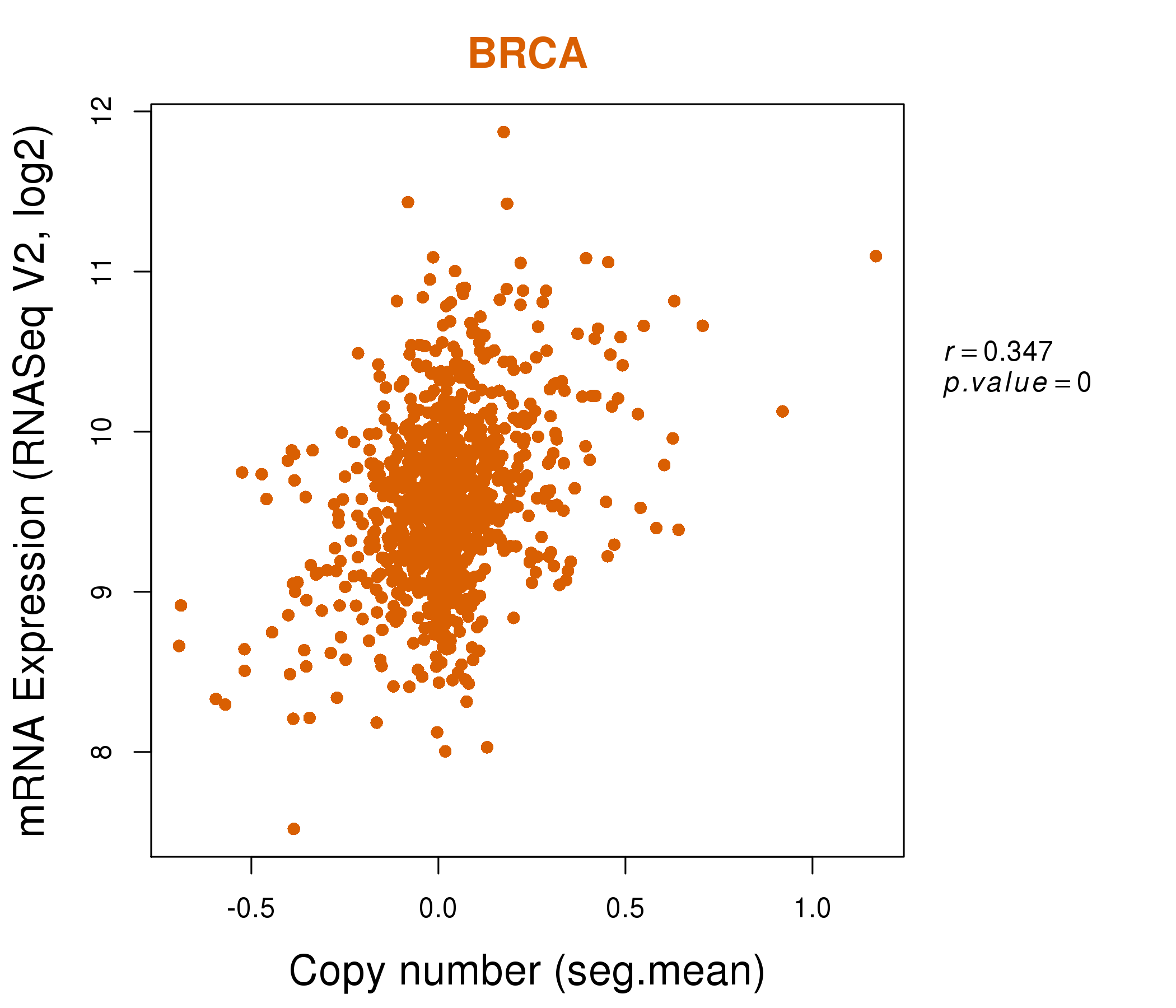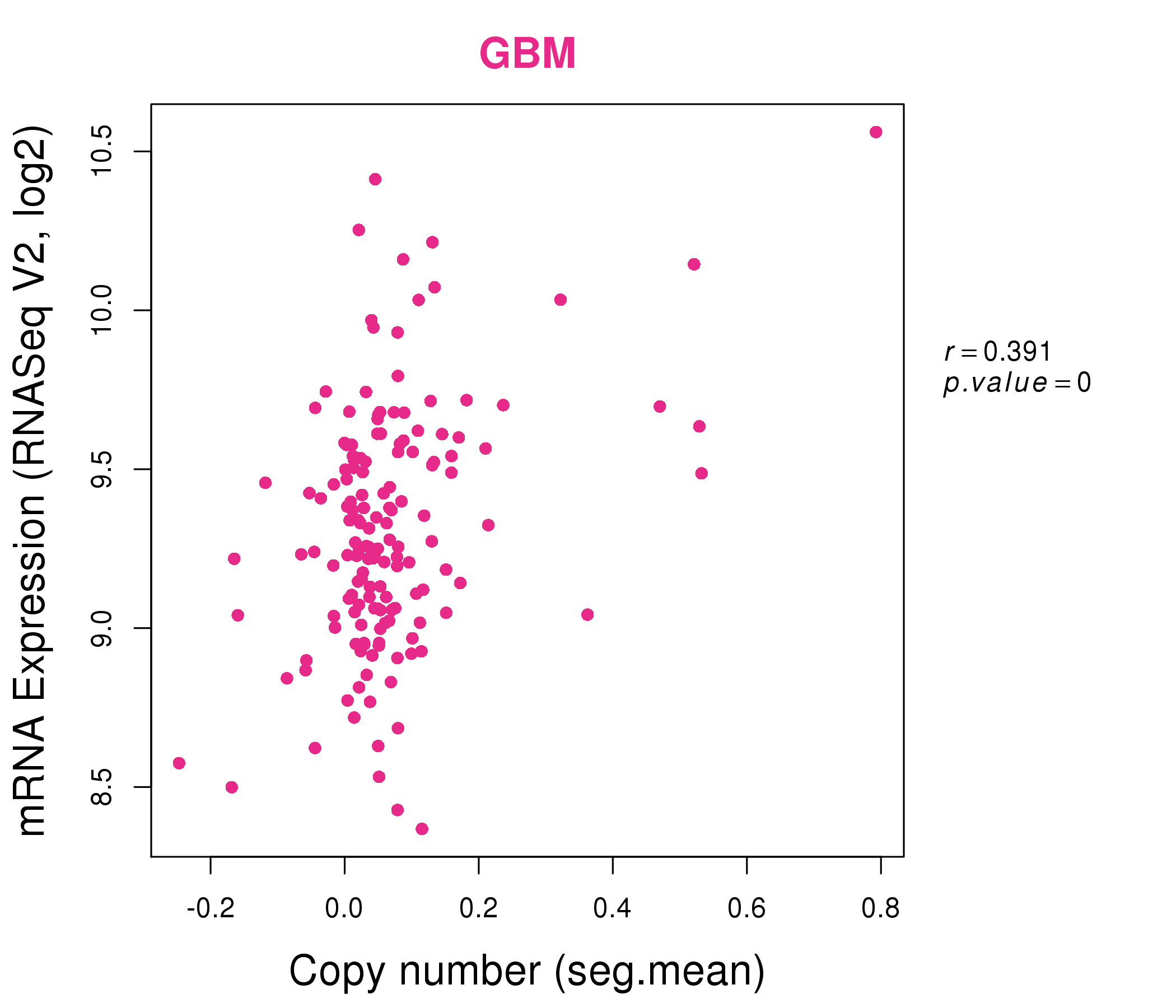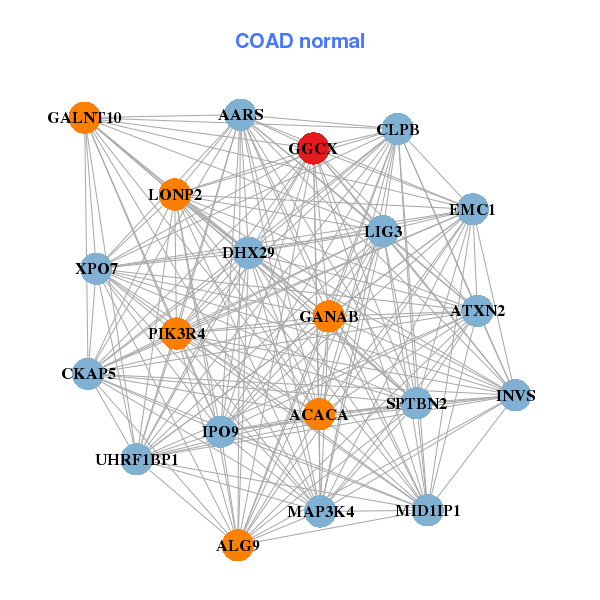|
|||||||||||||||||||||||||||||||||||||||||||||||||||||||||||||||||||||||||||||||||||||||||||||||||||||||||||||||||||||||||||||||||||||||||||||||||||||||||||||||||||||||||||||||||||||||||||||||||||||||||||||||||||||||||||||||||||||||||||||||||||||||||||||||||||||||||||||||||||||||||||||||||||||||||||||||||||||||||||||||||||||||||||||||||||||||||||||||||||||
| |
| Phenotypic Information (metabolism pathway, cancer, disease, phenome) |
| |
| |
| Gene-Gene Network Information: Co-Expression Network, Interacting Genes & KEGG |
| |
|
| Gene Summary for GGCX |
| Basic gene info. | Gene symbol | GGCX |
| Gene name | gamma-glutamyl carboxylase | |
| Synonyms | VKCFD1 | |
| Cytomap | UCSC genome browser: 2p12 | |
| Genomic location | chr2 :85771977-85788657 | |
| Type of gene | protein-coding | |
| RefGenes | NM_000821.5, NM_001142269.2, | |
| Ensembl id | ENSG00000115486 | |
| Description | peptidyl-glutamate 4-carboxylasevitamin K-dependent gamma-carboxylase | |
| Modification date | 20141222 | |
| dbXrefs | MIM : 137167 | |
| HGNC : HGNC | ||
| Ensembl : ENSG00000115486 | ||
| HPRD : 00665 | ||
| Vega : OTTHUMG00000130173 | ||
| Protein | UniProt: go to UniProt's Cross Reference DB Table | |
| Expression | CleanEX: HS_GGCX | |
| BioGPS: 2677 | ||
| Gene Expression Atlas: ENSG00000115486 | ||
| The Human Protein Atlas: ENSG00000115486 | ||
| Pathway | NCI Pathway Interaction Database: GGCX | |
| KEGG: GGCX | ||
| REACTOME: GGCX | ||
| ConsensusPathDB | ||
| Pathway Commons: GGCX | ||
| Metabolism | MetaCyc: GGCX | |
| HUMANCyc: GGCX | ||
| Regulation | Ensembl's Regulation: ENSG00000115486 | |
| miRBase: chr2 :85,771,977-85,788,657 | ||
| TargetScan: NM_000821 | ||
| cisRED: ENSG00000115486 | ||
| Context | iHOP: GGCX | |
| cancer metabolism search in PubMed: GGCX | ||
| UCL Cancer Institute: GGCX | ||
| Assigned class in ccmGDB | C | |
| Top |
| Phenotypic Information for GGCX(metabolism pathway, cancer, disease, phenome) |
| Cancer | CGAP: GGCX |
| Familial Cancer Database: GGCX | |
| * This gene is included in those cancer gene databases. |
|
|
|
|
|
| . | |||||||||||||||||||||||||||||||||||||||||||||||||||||||||||||||||||||||||||||||||||||||||||||||||||||||||||||||||||||||||||||||||||||||||||||||||||||||||||||||||||||||||||||||||||||||||||||||||||||||||||||||||||||||||||||||||||||||||||||||||||||||||||||||||||||||||||||||||||||||||||||||||||||||||||||||||||||||||||||||||||||||||||||||||||||||||||||||
Oncogene 1 | Significant driver gene in | ||||||||||||||||||||||||||||||||||||||||||||||||||||||||||||||||||||||||||||||||||||||||||||||||||||||||||||||||||||||||||||||||||||||||||||||||||||||||||||||||||||||||||||||||||||||||||||||||||||||||||||||||||||||||||||||||||||||||||||||||||||||||||||||||||||||||||||||||||||||||||||||||||||||||||||||||||||||||||||||||||||||||||||||||||||||||||||||||||||
| cf) number; DB name 1 Oncogene; http://nar.oxfordjournals.org/content/35/suppl_1/D721.long, 2 Tumor Suppressor gene; https://bioinfo.uth.edu/TSGene/, 3 Cancer Gene Census; http://www.nature.com/nrc/journal/v4/n3/abs/nrc1299.html, 4 CancerGenes; http://nar.oxfordjournals.org/content/35/suppl_1/D721.long, 5 Network of Cancer Gene; http://ncg.kcl.ac.uk/index.php, 1Therapeutic Vulnerabilities in Cancer; http://cbio.mskcc.org/cancergenomics/statius/ |
| REACTOME_METABOLISM_OF_PROTEINS | |
| OMIM | |
| Orphanet | |
| Disease | KEGG Disease: GGCX |
| MedGen: GGCX (Human Medical Genetics with Condition) | |
| ClinVar: GGCX | |
| Phenotype | MGI: GGCX (International Mouse Phenotyping Consortium) |
| PhenomicDB: GGCX | |
| Mutations for GGCX |
| * Under tables are showing count per each tissue to give us broad intuition about tissue specific mutation patterns.You can go to the detailed page for each mutation database's web site. |
| There's no structural variation information in COSMIC data for this gene. |
| * From mRNA Sanger sequences, Chitars2.0 arranged chimeric transcripts. This table shows GGCX related fusion information. |
| ID | Head Gene | Tail Gene | Accession | Gene_a | qStart_a | qEnd_a | Chromosome_a | tStart_a | tEnd_a | Gene_a | qStart_a | qEnd_a | Chromosome_a | tStart_a | tEnd_a |
| BQ355482 | GGCX | 17 | 299 | 2 | 85778146 | 85778430 | ZFP91 | 294 | 498 | 11 | 58387580 | 58387783 | |
| L17128 | ITPRIPL2 | 1 | 138 | 16 | 19130599 | 19130736 | GGCX | 125 | 2522 | 2 | 85776967 | 85788583 | |
| BE073949 | GGCX | 1 | 207 | 2 | 85779608 | 85780185 | GGCX | 203 | 266 | 2 | 85779567 | 85779630 | |
| Top |
| Mutation type/ Tissue ID | brca | cns | cerv | endome | haematopo | kidn | Lintest | liver | lung | ns | ovary | pancre | prost | skin | stoma | thyro | urina | |||
| Total # sample | 1 | 1 | ||||||||||||||||||
| GAIN (# sample) | 1 | 1 | ||||||||||||||||||
| LOSS (# sample) |
| cf) Tissue ID; Tissue type (1; Breast, 2; Central_nervous_system, 3; Cervix, 4; Endometrium, 5; Haematopoietic_and_lymphoid_tissue, 6; Kidney, 7; Large_intestine, 8; Liver, 9; Lung, 10; NS, 11; Ovary, 12; Pancreas, 13; Prostate, 14; Skin, 15; Stomach, 16; Thyroid, 17; Urinary_tract) |
| Top |
|
 |
| Top |
| Stat. for Non-Synonymous SNVs (# total SNVs=34) | (# total SNVs=13) |
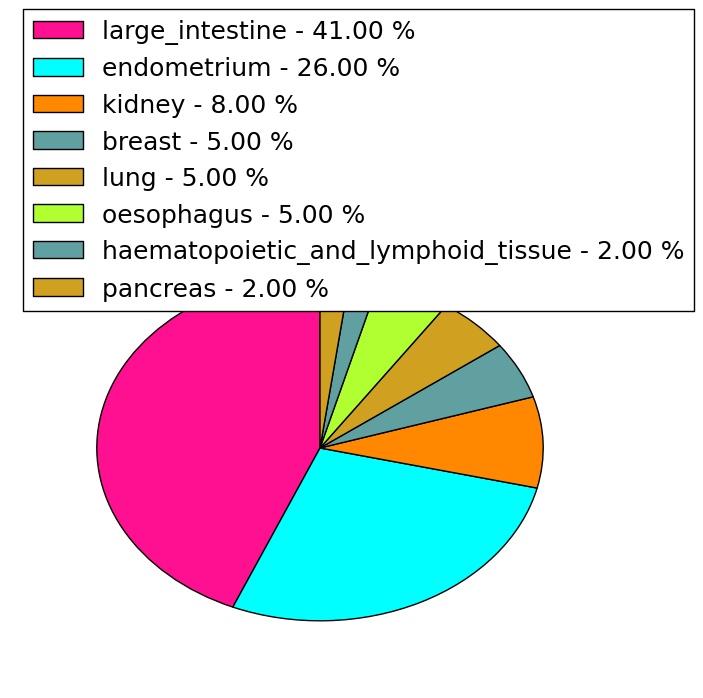 |  |
(# total SNVs=1) | (# total SNVs=0) |
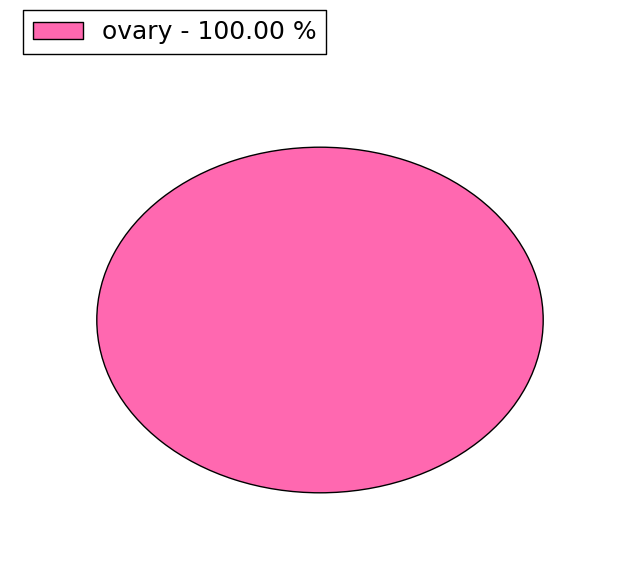 |
| Top |
| * When you move the cursor on each content, you can see more deailed mutation information on the Tooltip. Those are primary_site,primary_histology,mutation(aa),pubmedID. |
| GRCh37 position | Mutation(aa) | Unique sampleID count |
| chr2:85780131-85780131 | p.R406R | 3 |
| chr2:85783303-85783303 | p.? | 2 |
| chr2:85777139-85777139 | p.G732E | 2 |
| chr2:85780536-85780536 | p.R325Q | 2 |
| chr2:85777223-85777223 | p.R704Q | 2 |
| chr2:85779652-85779652 | p.D442E | 2 |
| chr2:85785695-85785695 | p.R136Q | 2 |
| chr2:85777724-85777724 | p.R680* | 2 |
| chr2:85780363-85780363 | p.L383I | 1 |
| chr2:85777744-85777744 | p.R673Q | 1 |
| Top |
|
 |
| Point Mutation/ Tissue ID | 1 | 2 | 3 | 4 | 5 | 6 | 7 | 8 | 9 | 10 | 11 | 12 | 13 | 14 | 15 | 16 | 17 | 18 | 19 | 20 |
| # sample | 3 | 1 | 8 | 1 | 4 | 2 | 6 | 4 | 11 | |||||||||||
| # mutation | 3 | 1 | 9 | 1 | 4 | 2 | 6 | 4 | 14 | |||||||||||
| nonsynonymous SNV | 2 | 8 | 1 | 4 | 1 | 4 | 3 | 9 | ||||||||||||
| synonymous SNV | 1 | 1 | 1 | 1 | 2 | 1 | 5 |
| cf) Tissue ID; Tissue type (1; BLCA[Bladder Urothelial Carcinoma], 2; BRCA[Breast invasive carcinoma], 3; CESC[Cervical squamous cell carcinoma and endocervical adenocarcinoma], 4; COAD[Colon adenocarcinoma], 5; GBM[Glioblastoma multiforme], 6; Glioma Low Grade, 7; HNSC[Head and Neck squamous cell carcinoma], 8; KICH[Kidney Chromophobe], 9; KIRC[Kidney renal clear cell carcinoma], 10; KIRP[Kidney renal papillary cell carcinoma], 11; LAML[Acute Myeloid Leukemia], 12; LUAD[Lung adenocarcinoma], 13; LUSC[Lung squamous cell carcinoma], 14; OV[Ovarian serous cystadenocarcinoma ], 15; PAAD[Pancreatic adenocarcinoma], 16; PRAD[Prostate adenocarcinoma], 17; SKCM[Skin Cutaneous Melanoma], 18:STAD[Stomach adenocarcinoma], 19:THCA[Thyroid carcinoma], 20:UCEC[Uterine Corpus Endometrial Carcinoma]) |
| Top |
| * We represented just top 10 SNVs. When you move the cursor on each content, you can see more deailed mutation information on the Tooltip. Those are primary_site, primary_histology, mutation(aa), pubmedID. |
| Genomic Position | Mutation(aa) | Unique sampleID count |
| chr2:85785695 | p.R79Q,GGCX | 2 |
| chr2:85781383 | p.S684Y,GGCX | 1 |
| chr2:85778065 | p.L452P,GGCX | 1 |
| chr2:85788065 | p.S171F,GGCX | 1 |
| chr2:85779652 | p.P670P,GGCX | 1 |
| chr2:85782632 | p.R441L,GGCX | 1 |
| chr2:85778102 | p.A136A,GGCX | 1 |
| chr2:85788077 | p.N648S,GGCX | 1 |
| chr2:85779675 | p.P427P,GGCX | 1 |
| chr2:85777112 | p.N130K,GGCX | 1 |
| * Copy number data were extracted from TCGA using R package TCGA-Assembler. The URLs of all public data files on TCGA DCC data server were gathered on Jan-05-2015. Function ProcessCNAData in TCGA-Assembler package was used to obtain gene-level copy number value which is calculated as the average copy number of the genomic region of a gene. |
 |
| cf) Tissue ID[Tissue type]: BLCA[Bladder Urothelial Carcinoma], BRCA[Breast invasive carcinoma], CESC[Cervical squamous cell carcinoma and endocervical adenocarcinoma], COAD[Colon adenocarcinoma], GBM[Glioblastoma multiforme], Glioma Low Grade, HNSC[Head and Neck squamous cell carcinoma], KICH[Kidney Chromophobe], KIRC[Kidney renal clear cell carcinoma], KIRP[Kidney renal papillary cell carcinoma], LAML[Acute Myeloid Leukemia], LUAD[Lung adenocarcinoma], LUSC[Lung squamous cell carcinoma], OV[Ovarian serous cystadenocarcinoma ], PAAD[Pancreatic adenocarcinoma], PRAD[Prostate adenocarcinoma], SKCM[Skin Cutaneous Melanoma], STAD[Stomach adenocarcinoma], THCA[Thyroid carcinoma], UCEC[Uterine Corpus Endometrial Carcinoma] |
| Top |
| Gene Expression for GGCX |
| * CCLE gene expression data were extracted from CCLE_Expression_Entrez_2012-10-18.res: Gene-centric RMA-normalized mRNA expression data. |
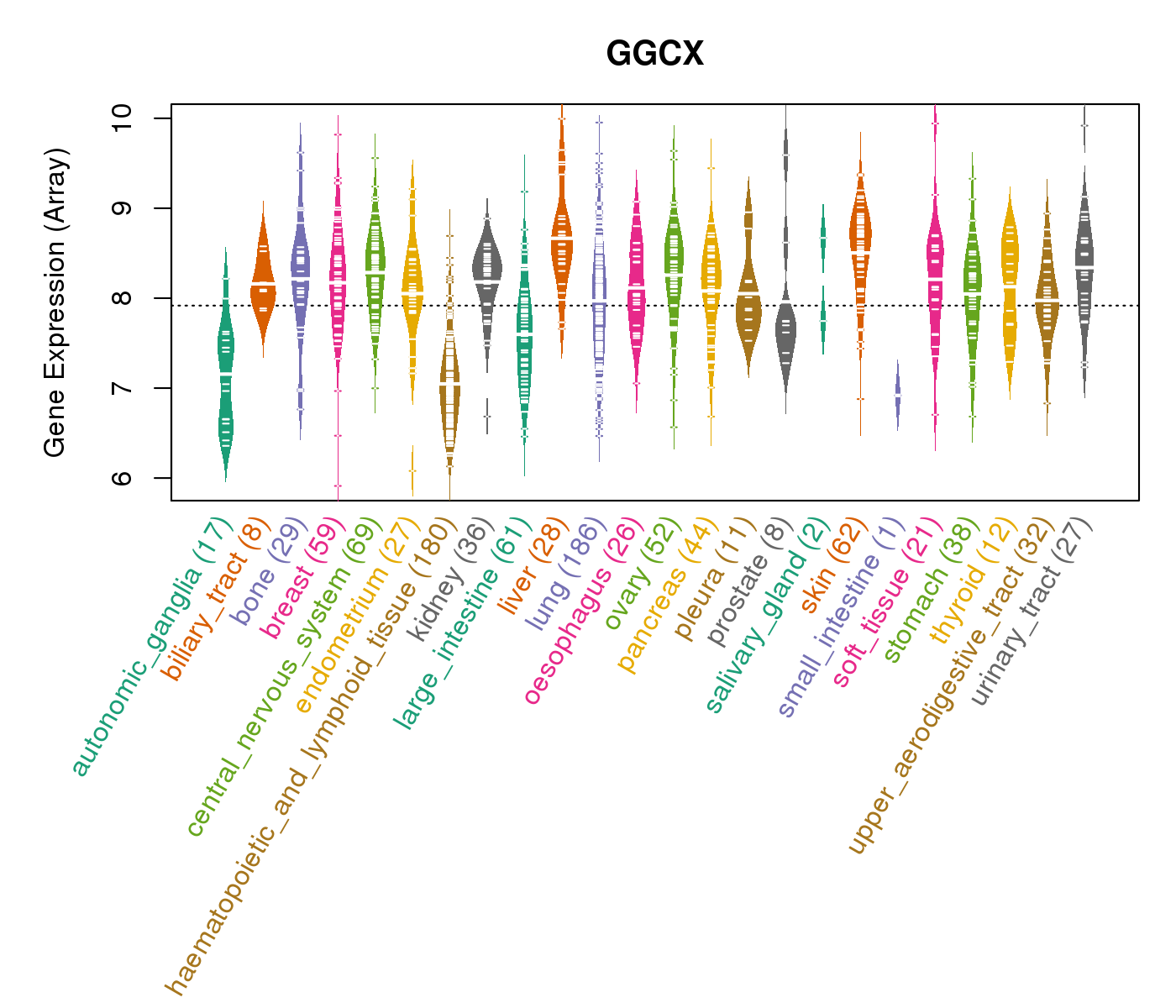 |
| * Normalized gene expression data of RNASeqV2 was extracted from TCGA using R package TCGA-Assembler. The URLs of all public data files on TCGA DCC data server were gathered at Jan-05-2015. Only eight cancer types have enough normal control samples for differential expression analysis. (t test, adjusted p<0.05 (using Benjamini-Hochberg FDR)) |
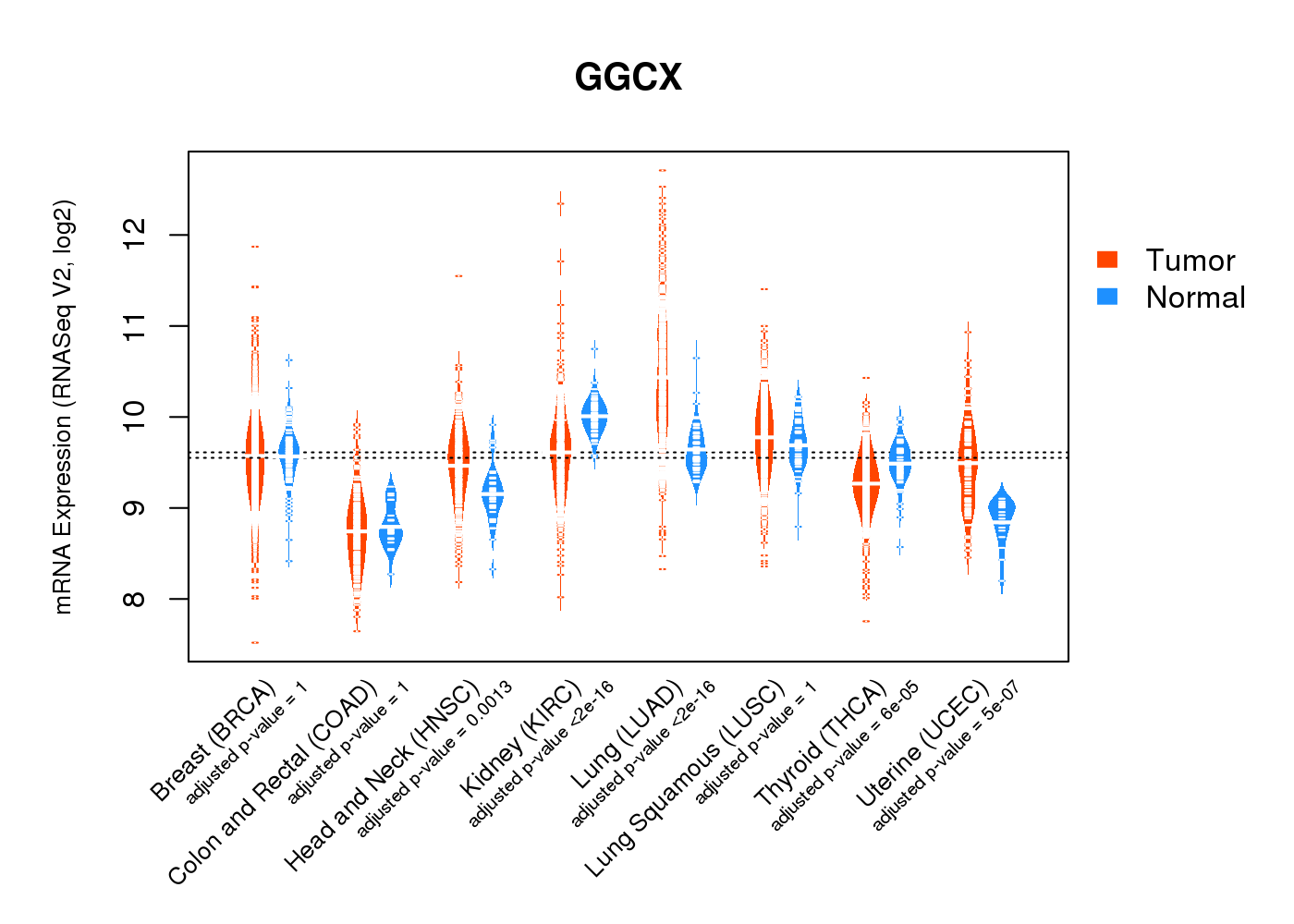 |
| Top |
| * This plots show the correlation between CNV and gene expression. |
: Open all plots for all cancer types
 |
|
 |
|
| Top |
| Gene-Gene Network Information |
| * Co-Expression network figures were drawn using R package igraph. Only the top 20 genes with the highest correlations were shown. Red circle: input gene, orange circle: cell metabolism gene, sky circle: other gene |
: Open all plots for all cancer types
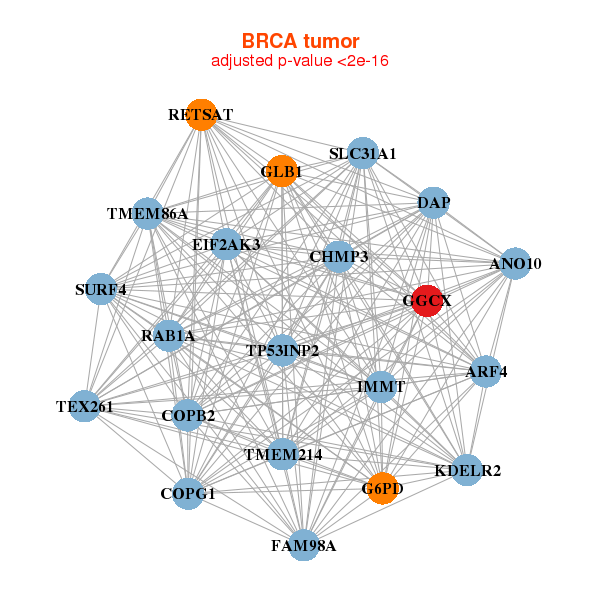 |
| ||||
| ANO10,ARF4,COPB2,COPG1,DAP,EIF2AK3,FAM98A, G6PD,GGCX,GLB1,IMMT,KDELR2,RAB1A,RETSAT, SLC31A1,SURF4,TEX261,TMEM214,TMEM86A,TP53INP2,CHMP3 | ABCB6,ACACA,AGPAT3,ANO10,BRI3BP,C9orf91,COPB2, COPG1,CRK,FADS2,FAR2,FITM2,GGCX,HFE, LONP2,NQO1,PAPSS2,SCP2,SLC41A2,SLC5A3,TBC1D24 | ||||
 |
| ||||
| B3GNT9,CABIN1,CDR2L,DUSP7,FAM63B,FICD,FRRS1, FUT11,GGCX,HDLBP,LEPRE1,NRBP1,PANX1,PDE4DIP, PLBD2,PLOD1,SERPINH1,TANC2,TMEM106A,TMEM184B,ZNF70 | AARS,ACACA,ALG9,ATXN2,CKAP5,CLPB,DHX29, GALNT10,GANAB,GGCX,INVS,IPO9,EMC1,LIG3, LONP2,MAP3K4,MID1IP1,PIK3R4,SPTBN2,UHRF1BP1,XPO7 |
| * Co-Expression network figures were drawn using R package igraph. Only the top 20 genes with the highest correlations were shown. Red circle: input gene, orange circle: cell metabolism gene, sky circle: other gene |
: Open all plots for all cancer types
| Top |
: Open all interacting genes' information including KEGG pathway for all interacting genes from DAVID
| Top |
| Pharmacological Information for GGCX |
| DB Category | DB Name | DB's ID and Url link |
| * Gene Centered Interaction Network. |
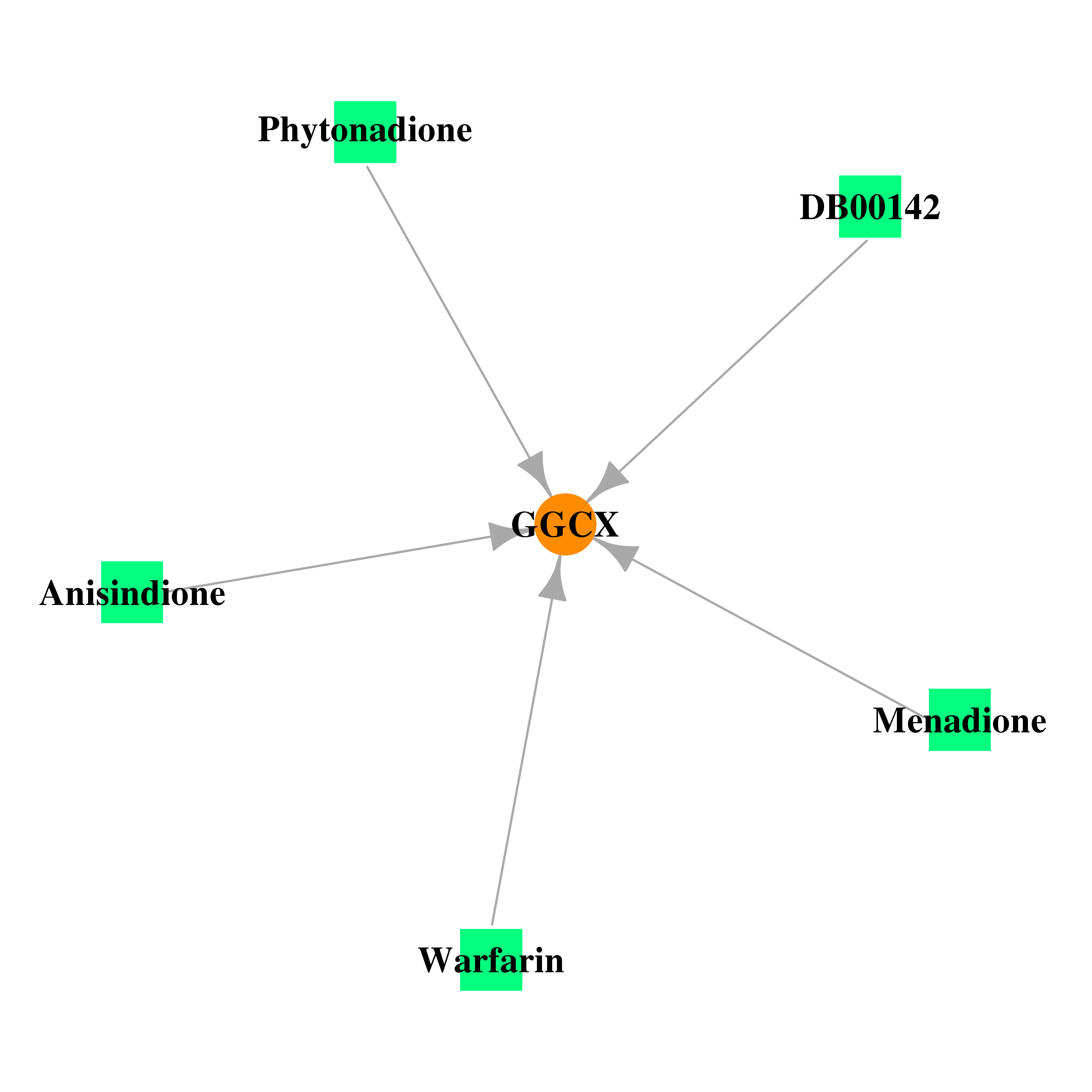 |
| * Drug Centered Interaction Network. |
| DrugBank ID | Target Name | Drug Groups | Generic Name | Drug Centered Network | Drug Structure |
| DB00142 | gamma-glutamyl carboxylase | approved; nutraceutical | L-Glutamic Acid | 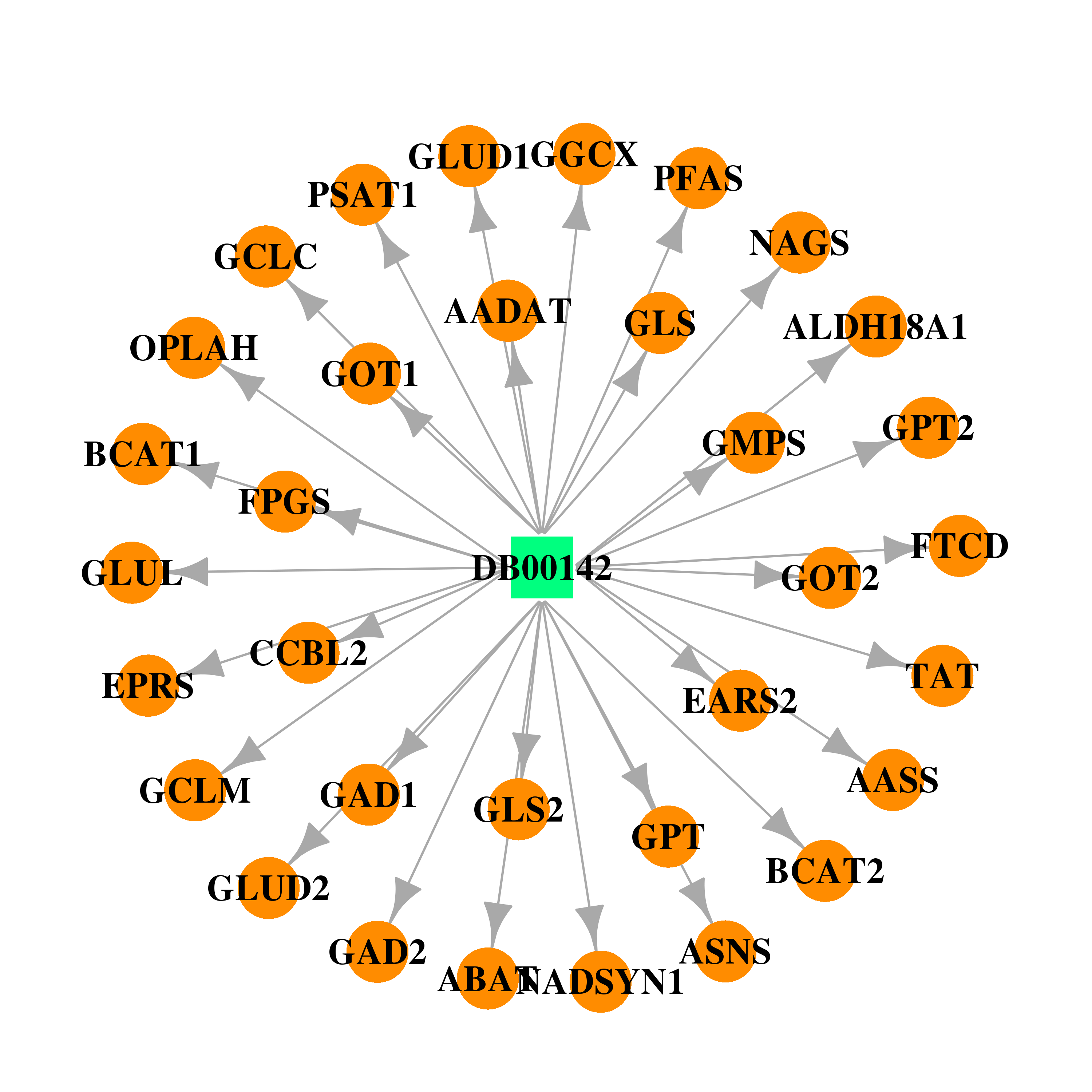 | 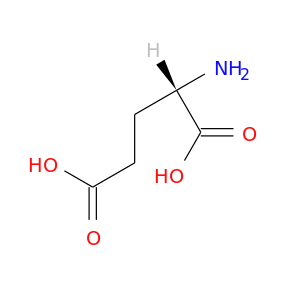 |
| DB00170 | gamma-glutamyl carboxylase | approved; nutraceutical | Menadione |  |  |
| DB01022 | gamma-glutamyl carboxylase | approved | Phytonadione |  | 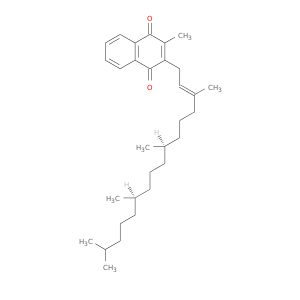 |
| DB01125 | gamma-glutamyl carboxylase | approved | Anisindione |  |  |
| DB00682 | gamma-glutamyl carboxylase | approved | Warfarin |  | 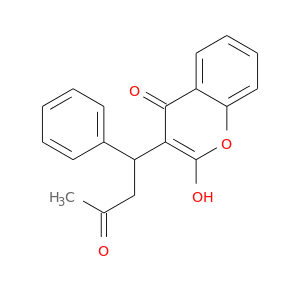 |
| Top |
| Cross referenced IDs for GGCX |
| * We obtained these cross-references from Uniprot database. It covers 150 different DBs, 18 categories. http://www.uniprot.org/help/cross_references_section |
: Open all cross reference information
|
Copyright © 2016-Present - The Univsersity of Texas Health Science Center at Houston @ |






